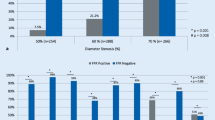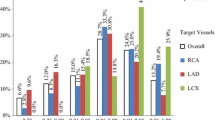Abstract
Fractional flow reserve (FFR) has become an increasingly important index for decision making concerning coronary revascularization. It is commonly accepted that significant improvement in FFR following percutaneous coronary intervention (PCI) is associated with better symptomatic relief and a lower event rate. However, in lesions with insufficient FFR improvement, PCI may not improve prognosis. Leading to the observation that the clinical and angiographic characteristics associated with insufficient FFR improvement have not been fully explored. The purpose of this study was to investigate the factors associated with insufficient improvement in FFR. Using our own PCI database, established between January 2014 and December 2018, we identified 220 stable coronary artery lesions, which had been evaluated for both pre- and post-PCI FFR values. All 220 of these lesions were included in this study. The improvement in FFR (ΔFFR) was calculated in each lesion with the lowest quartile of ΔFFR being defined as the lowest ΔFFR group, and the other quartiles being defined as the intermediate-high ΔFFR group. The mean ΔFFR in the lowest and intermediate-high ΔFFR groups was 0.07 ± 0.02 and 0.21 ± 0.11, respectively. In multivariate logistic regression analysis, a short total stent length (10 mm increase: OR 0.67, 95% CI 0.47–0.96, P = 0.030), higher pre-PCI FFR (0.1 increase: OR 4.07, 95% CI 1.83–9.06, P = 0.001), in-stent restenosis (ISR) (OR 8.02, 95% CI 1.26–51.09, P = 0.028), myocardial infarction (MI) in the target vessel (OR 6.87, 95% CI 1.19–39.69, P = 0.031) and non-use of intravascular imaging (OR 0.35, 95% CI 0.12–0.99, P = 0.048) were significantly associated with the lowest ΔFFR group. The use of short stents, higher pre-PCI FFR values, ISR, MI in the target vessel, and non-use of intravascular imaging were significantly associated with insufficient FFR improvement. It was conversely suggested that full coverage and adequate dilatation of the lesions under an intravascular imaging guidance might contribute to an improvement in FFR.




Similar content being viewed by others
References
Tonino PA, De Bruyne B, Pijls NH, Siebert U, Ikeno F, van' t Veer M, Klauss V, Manoharan G, Engstrom T, Oldroyd KG, Ver Lee PN, MacCarthy PA, Fearon WF (2009) Fractional flow reserve versus angiography for guiding percutaneous coronary intervention. N Engl J Med 360(3):213–224
De Bruyne B, Pijls NH, Kalesan B, Barbato E, Tonino PA, Piroth Z, Jagic N, Mobius-Winkler S, Rioufol G, Witt N, Kala P, MacCarthy P, Engstrom T, Oldroyd KG, Mavromatis K, Manoharan G, Verlee P, Frobert O, Curzen N, Johnson JB, Juni P, Fearon WF (2012) Fractional flow reserve-guided PCI versus medical therapy in stable coronary disease. N Engl J Med 367(11):991–1001
Knuuti J, Wijns W, Saraste A, Capodanno D, Barbato E, Funck-Brentano C, Prescott E, Storey RF, Deaton C, Cuisset T, Agewall S, Dickstein K, Edvardsen T, Escaned J, Gersh BJ, Svitil P, Gilard M, Hasdai D, Hatala R, Mahfoud F, Masip J, Muneretto C, Valgimigli M, Achenbach S, Bax JJ, Group ESCSD (2019) ESC guidelines for the diagnosis and management of chronic coronary syndromes. Eur Heart J 41(3):407–477
Li SJ, Ge Z, Kan J, Zhang JJ, Ye F, Kwan TW, Santoso T, Yang S, Sheiban I, Qian XS, Tian NL, Rab TS, Tao L, Chen SL (2017) Cutoff value and long-term prediction of clinical events by ffr measured immediately after implantation of a drug-eluting stent in patients with coronary artery disease: 1- to 3-year results from the DKCRUSH VII Registry Study. JACC Cardiovasc Interv 10(10):986–995
Piroth Z, Toth GG, Tonino PAL, Barbato E, Aghlmandi S, Curzen N, Rioufol G, Pijls NHJ, Fearon WF, Juni P, De Bruyne B (2017) Prognostic value of fractional flow reserve measured immediately after drug-eluting stent implantation. Circ Cardiovasc Interv 10(8):e005233
Fournier S, Ciccarelli G, Toth GG, Milkas A, Xaplanteris P, Tonino PAL, Fearon WF, Pijls NHJ, Barbato E, De Bruyne B (2019) Association of improvement in fractional flow reserve with outcomes, including symptomatic relief after percutaneous coronary intervention. JAMA Cardiol 4(4):370–374
Kim HL, Koo BK, Nam CW, Doh JH, Kim JH, Yang HM, Park KW, Lee HY, Kang HJ, Cho YS, Youn TJ, Kim SH, Chae IH, Choi DJ, Kim HS, Oh BH, Park YB (2012) Clinical and physiological outcomes of fractional flow reserve-guided percutaneous coronary intervention in patients with serial stenoses within one coronary artery. JACC Cardiovasc Interv 5(10):1013–1018
Park SJ, Ahn JM, Pijls NH, De Bruyne B, Shim EB, Kim YT, Kang SJ, Song H, Lee JY, Kim WJ, Park DW, Lee SW, Kim YH, Lee CW, Park SW (2012) Validation of functional state of coronary tandem lesions using computational flow dynamics. Am J Cardiol 110(11):1578–1584
Thygesen K, Alpert JS, Jaffe AS, Simoons ML, Chaitman BR, White HD, Joint ESCAAHAWHFTFfUDoMI, Authors/Task Force Members C, Thygesen K, Alpert JS, White HD, Biomarker S, Jaffe AS, Katus HA, Apple FS, Lindahl B, Morrow DA, Subcommittee ECG, Chaitman BR, Clemmensen PM, Johanson P, Hod H, Imaging S, Underwood R, Bax JJ, Bonow JJ, Pinto F, Gibbons RJ, Classification S, Fox KA, Atar D, Newby LK, Galvani M, Hamm CW, Intervention S, Uretsky BF, Steg PG, Wijns W, Bassand JP, Menasche P, Ravkilde J, Ohman EM, Antman EM, Wallentin LC, Armstrong PW, Simoons ML, Trials, Registries S, Januzzi JL, Nieminen MS, Gheorghiade M, Filippatos G, Luepker RV, Fortmann SP, Rosamond WD, Levy D, Wood D, Smith SC, Hu D, Lopez-Sendon JL, Robertson RM, Weaver D, Tendera M, Bove AA, Parkhomenko AN, Vasilieva EJ, Mendis S, Bax JJ, Guidelines ESCCfP, Baumgartner H, Ceconi C, Dean V, Deaton C, Fagard R, Funck-Brentano C, Hasdai D, Hoes A, Kirchhof P, Knuuti J, Kolh P, McDonagh T, Moulin C, Popescu BA, Reiner Z, Sechtem U, Sirnes PA, Tendera M, Torbicki A, Vahanian A, Windecker S, Document R, Morais J, Aguiar C, Almahmeed W, Arnar DO, Barili F, Bloch KD, Bolger AF, Botker HE, Bozkurt B, Bugiardini R, Cannon C, de Lemos J, Eberli FR, Escobar E, Hlatky M, James S, Kern KB, Moliterno DJ, Mueller C, Neskovic AN, Pieske BM, Schulman SP, Storey RF, Taubert KA, Vranckx P, Wagner DR (2012) Third universal definition of myocardial infarction. J Am Coll Cardiol 60(16):1581–1598
Kawase Y, Matsuo H, Akasaka T, Shiono Y, Tanaka N, Amano T, Kozuma K, Nakamura M, Yokoi H, Kobayashi Y, Ikari Y (2019) Clinical use of physiological lesion assessment using pressure guidewires: an expert consensus document of the Japanese Association of Cardiovascular Intervention and Therapeutics. Cardiovasc Interv Ther 34(1):85–96
Jang HJ, Koo BK, Lee HS, Park JB, Kim JH, Seo MK, Yang HM, Park KW, Nam CW, Doh JH, Kim HS (2013) Safety and efficacy of a novel hyperaemic agent, intracoronary nicorandil, for invasive physiological assessments in the cardiac catheterization laboratory. Eur Heart J 34(27):2055–2062
Kimura Y, Tanaka N, Okura H, Yoshida K, Akabane M, Takayama T, Hirayama A, Tada T, Kimura T, Takano H, Mizuno K, Inami T, Yoshino H, Yamashina A (2016) Characterization of real-world patients with low fractional flow reserve immediately after drug-eluting stents implantation. Cardiovasc Interv Ther 31(1):29–37
Tanaka N, Pijls NH, Yamashita J, Kimura Y, Ogawa M, Murata N, Sakoda K, Hoshino K, Hokama Y, Yamashina A (2017) Analysis of suboptimal stent deployment using intravascular ultrasound and coronary pressure pullback measurement. J Cardiol 69(4):613–618
Kang DY, Ahn JM, Lee CH, Lee PH, Park DW, Kang SJ, Lee SW, Kim YH, Lee CW, Park SW, Park SJ (2018) Deferred vs. performed revascularization for coronary stenosis with grey-zone fractional flow reserve values: data from the IRIS-FFR registry. Eur Heart J 39(18):1610–1619
Alfonso F, Garcia J, Perez-Vizcayno MJ, Hernando L, Hernandez R, Escaned J, Jimenez-Quevedo P, Banuelos C, Macaya C (2009) New stent implantation for recurrences after stenting for in-stent restenosis: implications of a third metal layer in human coronary arteries. J Am Coll Cardiol 54(11):1036–1038
De Bruyne B, Pijls NH, Bartunek J, Kulecki K, Bech JW, De Winter H, Van Crombrugge P, Heyndrickx GR, Wijns W (2001) Fractional flow reserve in patients with prior myocardial infarction. Circulation 104(2):157–162
Acknowledgements
The authors acknowledge all staff in the catheter laboratory in Shin-Koga Hospital for their technical support in this study.
Author information
Authors and Affiliations
Corresponding author
Ethics declarations
Conflict of interest
All authors and co-authors have no conflicts of interest to disclose.
Additional information
Publisher's Note
Springer Nature remains neutral with regard to jurisdictional claims in published maps and institutional affiliations.
Rights and permissions
About this article
Cite this article
Hirai, K., Kawasaki, T., Sakakura, K. et al. Determinants of insufficient improvement in fractional flow reserve following percutaneous coronary intervention. Heart Vessels 35, 1650–1656 (2020). https://doi.org/10.1007/s00380-020-01645-6
Received:
Accepted:
Published:
Issue Date:
DOI: https://doi.org/10.1007/s00380-020-01645-6




